
Olive Tree in Philippines
The olive (Olea europaea) is a stone fruit from a species of small tree in the family Oleaceae. Olives are found primarily in the Mediterranean Basin and across the countries of the middle east and north Africa (MENA). Olives are now cultivated in India and as far east as China, Java, Australia and the Philippines. Off north Africa, olives are found in the The Canary and Réunion Islands. Spanish settlers brought olive trees to the New World. Olives are now cultivated in Mexico, Argentina, Peru, Chile and several other Central and South American countries. In the United States, olives are grown in Texas, Alabama, Georgia, Florida, Arizona and California. There are olive trees on Bermuda and on the U.S. East Coast barrier islands in Georgia and the Carolinas (Norfolk Island and Cumberland Island).
All olive are green when young, as they ripen they turn black. So-called black olives one might find in the market are treated with iron (Fe) to turn them from green to black.
An Olive Oil Story
In Greek mythology, the primary god, Zeus, promised to give the region of Attica (current day Athens) to the god or goddess who made the most useful invention. The two finalists were Athena, the goddess of Wisdom and War; and Poseidon, ruler of the Sea, Earthquakes and Horses.
Zeus picked his daughter Athena’s gift of the olive: useful for light, heat, food, medicine and perfume as a more peaceful and worthy invention than Poseidon’s horse – a rapid and powerful instrument of war.

Acropolis (Athens, Greece)
Legend says Athena planted the original olive tree on a rocky hill today known as the Acropolis. The olive tree now growing there is said to have come from the roots of Athena’s original tree. A single olive tree can live one thousand years or more.
The modern day olive (Olea europaea) is among the oldest known cultivated trees in the world – grown before written language. The olive is thought to be native to Asia Minor. It’s value as a food and fuel caused it to spread from the “fertile crescent” (Syria, Iraq, Iran) to the rest of the Mediterranean basin approximately 6,000 years ago.
There is some disagreement about which is the oldest living olive tree. The olive tree at Vouves (Crete) is thought by some to be over 3,000 years old. The al Badawi olive tree in Bethlehem is reputed to be the oldest in the world at somewhere between 4,000 and 5,000 years. Olives have been found in Egyptian tombs dating 2,000 years B.C. The Fargo Olive, a tree recently used by Spanish scientists to document the olive genome, has been verified as 1200 years old.
In a dig at the site of the Bronze Age town of Ein Zippori, just over a mile west of Nazareth, Israeli researchers unearthed shards of broken pottery containers. Chemical analyses of the shards revealed traces of an 8,000 year-old olive oil. Trees on Jerusalem’s Mount of Olives are reputed to be 2000 years old.
While olive oil was produced in small quantities throughout the ancient world, the Minoan civilization (3,000 BC) on the Greek island of Crete found olive oil to be a major source of the wealth.

Minoan olive oil production at Phaistos
Sailing from Minoan ports on the north (Knossos) and south (Phaistos) shores of Crete, Phoenician traders bought Minoan olive oil and sold it throughout the Mediterranean, Africa and Southern Europe. Early Greek olive culture was adopted by the Romans and brought to virtually every settlement in the Mediterranean basin and beyond.
Recently, scientists analyzed 14 olive trees (Olea europea) in the Montsià region of Spain using a technique allowing for the extraction of a small cylindrical piece of the trunk which goes from the bark to the core of the tree. Studying the rings and other information contained in the core sample, the oldest of 14 trees tested turned out to be 627 years, not up to a thousand year standard but still fairly impressive.
Fourteen hundred years ago the Prophet of Islam, Muhammad (عليه السلام) used olive oil as a head anointment and advised his followers to apply olive oil to their bodies. The use of olive oil is found in many religions and cultures. It has been used in special ceremonies as well as a general health measure. During baptism in the Catholic church, “holy oil”, which is often olive oil, may be used for anointment. At the Christmas mass in the Catholic church olive oil blessed by the bishop is used in the ceremony.
Olive oil was used to anoint the early kings of the Greeks and Jews. The Greeks anointed winning athletes. Olive oil has also been used to anoint the dead in many cultures. Like the grape, the Catholic Franciscan monks brought the olive tree to California for food and ceremonial use.
Man has manipulated the olive tree for so many thousands of years that it is unclear what varieties came from which other varieties. Varieties in one country have been found to be identical to differently named varieties in another. Some research is now being done using gene mapping techniques to figure out the olive family tree. Shrub-like “feral” olives still exist in the Middle East and represent the original stock from which all other olives are descended. In the past several hundred years the olive has spread to North and South America, Japan, New Zealand and Australia.
Editor’s Note: Information for this article has been gleaned from several sources including Wikipedia.
No one is quite sure where olives come from – there are several “theories” as to how the olive evolved. One theory suggests the olive we enjoy today (Olea europaea L.) had origins in southern Syria. Other theories suggest the early olive originated in Iran or Turkey. According to Wikipedia, fossil evidence indicates the olive tree had its origins some 20–40 million years ago (the Oligocene period) in an area corresponding to Italy and the eastern Mediterranean Basin. Some suggest olives originated in the Fertile Crescent (Iraq/Iran) – some think olives originated in what is now modern day Turkey. Fossil evidence suggests the olive plant was first cultivated some 7,000 years ago in Mediterranean regions. The edible olive seems to have coexisted with humans for about 5,000 to 6,000 years, going back to the early Bronze Age (3150 to 1200 BC). Based on written tablets, olive pits, and wood fragments found in ancient tombs, the olive’s origin as an economic crop can be traced to the areas in the Levant (modern day Israel and Lebanon) and the nearby islands of Cyprus and Crete.
Olive trees can grow very large. Depending on variety, age and pruning; the tree can grow to 30 feet (9 meters)

Henri Bos and his 7 year old olive tree
Generally, olives can survive in temperatures above 20 degrees F. However, young olive trees (under 3 years old) can be sensitive to long cold spells – dropping leaves and loosing branches. Often however, they will come back from the roots. Olive trees younger than one year should be protected from freezing. Regarding humidity, there is not enough research to make a determination to what degree does humidity (and in what amounts and at what times during the olive growing season) impact olive tree cultivation in Florida. Some say too much humidity during pollination results in diminished fruit set, but there is no data known to us supporting this hypothesis. According to Israeli researchers, “olives perform well, with humidity varying between 40%–65 %. High humidity, above 80%, at flowering causes flower drop and infestation by sooty-mold producing insects.”
The number #1 killer of olives is too much water. Once the olive roots become saturated, the tree will not live long. Almost nothing else will kill an olive tree. It will freeze and appear dead but often it will come back from the roots.
In Florida, few insects significantly damage olive trees.

Stink Bug (Halyomorpha halys)
Leaf hoppers may chew a few leaves and Stink Bugs will attack the fruit.

Olives with Anthracnose disease
Anthracnose and a few other diseases affect olive trees in Florida. Click here to download the UF-IFAS paper on Pests and Diseases of Olives in Florida.
Olives need some nutrition depending on several factors. Some long-time Florida olive growers use a 14-14-14 mix with minors. Others use a straight 10-10-10 mixture. It is best to make sure your soil pH is between 6.5 and 7.5 and has requisite minor elements. There is no substitution for a good soil sample before planting. Olives generally need nitrogen during early spring growing season, later some growers suggest add potash (K) is important for blooming and fruit set. The best advice is to plant in good soil and begin a basic fertilization scheme. After a couple of years of leaf tissue sample information, you will be able to determine a good approach to nutrition.
Eating olives directly off the tree is not a good idea. They are quite bitter. Olives are generally cured in a salt solution before eating. Some processors use lye to cure olives as this speeds the curing process. Olives can be cured over a long period in pure water but the water must be changed often and the process can take months as opposed to weeks or days with salt or lye.
Olive Oil is the juice from the olive. Olive oil is composed mainly of triacylglycerols (triglycerides or fats) and contains small quantities of free fatty acids (FFA), glycerol, phosphatides, pigments, flavor compounds, sterols, and microscopic bits of olive. Triacylglycerols are the major energy reserve for plants and animals. Chemically speaking, these are molecules derived from the natural esterification of three fatty acid molecules with a glycerol molecule. The glycerol molecule can simplistically be seen as an “E-shaped” molecule, with the fatty acids in turn resembling longish hydrocarbon chains, varying (in the case of olive oil) from about 14 to 24 carbon atoms in length. (Thanks to Olive Oil Source)
Thousands of kinds of olive oil are produced
See standards.
narrative here
No – it can be tampered with – added Chlorophyll
Several things to consider
Hair care, body oils, extracts., etc
The benefits are many. The United States National Institutes of Health have an extensive library on olive oil, leaf extracts and other components of the olive. The polyphenol content of olive oil is extraordinary among plants. The anti-inflammatory properties of the olive have been known for centuries. Cultures who consume a regular diet of olive oil and vegetable fiber (Mediterranean Diet) have a lower instance of cancer and heart disease. Click here for a peer-reviewed study (2018).
The amount of olives needed to make oil varies with variety, season, cultivation practices and many other variables. He is a link to a short article describing olive crop estimation and related oil content and production characteristics. While some groves my produce 200 gallons of oil per acre, other groves with the same varieties and of the same age in the same location produce less than half that amount. Grove management is key.
We need your help.
The Florida Olive Council is a non-profit organization certified under Federal tax code 501(c)(3) and Florida statutes Chapter 617. We are supported by your contributions. Ninety-five (95%) of your donation goes directly to supporting olive research. Our directors and officers receive no salary or other compensation. Donate
